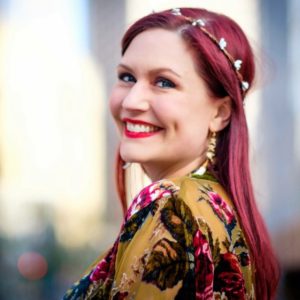 2017 Accelerator Fellow
2017 Accelerator Fellow
Where did you grow up?
Minneapolis, Minnesota.
When/how did you first know that you wanted to be an artist?
I’m pretty sure that I’ve always been one. Although there have been fleeting moments where I found myself wishing that art was less of a priority for me, there’s no escaping yourself. I’ve never been one to choose the easy path as a way of avoiding struggle or pain. I couldn’t be anything but an artist.
Where do you currently live/work, and how would you describe the arts community there?
The Minneapolis art community is quite varied. We have great museums and galleries that feature world-class art. We are also blessed to have a very active music and theater community. I am a concert enthusiast, so the local music community informs my work to a great degree.
I lived on the West Coast for a decade, and the flow of creativity is different here, in large part because of the extreme weather changes we experience.
Winter is a time to research, create the bulk of my work, and begin projects that require time and focus. It gets dark at 5:00pm, and my home is blanketed in snow, so that promotes a natural kind of isolation—it’s the season with the fewest interruptions. I take advantage of these conditions to write and reflect, apply for opportunities, and set goals for the coming year. Winter’s solitary hours lead to social awkwardness at the start of the spring, but then it’s time to reach out and share what I’ve been doing with my creative allies. Together, we brainstorm the best possible outcomes for our projects to bring them to fruition. Summer is a shot of adrenaline to the heart, an explosion of pent-up energy—although the season feels about two weeks long to me, as I hop around trying to keep up with opportunities to connect, including music festivals, art markets, and other outdoor shenanigans. Autumn is my favorite season. It is preparation time, the incubation stage for the creative process; it’s when I make plans, hoard the necessary supplies, and take in the bright colors of the trees and the smell of the wind.
I have grown attached to these seasonal rhythms, and I plan my creative endeavors according to Minnesota’s natural shifts.
How would you describe your art to someone who’s never seen it?

I create highly detailed collage works that incorporate mixed-media techniques. The elements come primarily from used books, but I enhance their inherent colors to create vivid, saturated tones. I embellish my materials using various tools and techniques, including drawing, outlining, metallic leafing, and other textural surface treatments that allow me to evolve the work beyond collage. I am interested in luminosity, reflection, and the play of light on the surfaces of my works.
The subject matter runs the gamut of my interests. I am inspired by a tsunami of sources—including the natural world, collections of curiosities, states of consciousness, lucid dreaming, music, religious iconography, mythology, and fairytales. My pieces explore the possibility of magic and our most vivid emotional states, such as ecstasy and the perils and thrills of love. Some of my work establishes a narrative, while other pieces are more open-ended or opaque, using the juxtaposition of various elements as a kind of Rorschach test—one that leaves viewers to define a work’s meaning for themselves. My compositions are comparable in arrangement to those found in many Wunderkammern, a.k.a. cabinets of curiosity.
My recent collage work varies greatly in size, from 4″ to 32″, though the trend is toward the larger end of that spectrum. I most often create within squares or circles—partly because their particular geometry infuses the work with a sense of wholeness, and partly because those forms are easier to evolve into album art for musician friends.
My aesthetic is “more is more,” as I embellish and painstakingly arrange the elements to create harmony, balance, and a sense of wholeness. I often prepare three times as many elements as end up in a final piece, and the extras get filed away in my cabinet for future works.
What do you hope to communicate to your audience?
It varies from series to series, of course, but overall, I am attempting to elicit and connect to the emotional and intellectual responses in my audience. I am interested in how each viewer experiences and interprets the symbolic language I present. We all partake of a collective unconscious, centuries of stories and symbols that partially define our understanding of the world, and then our individual experiences further color our perspectives. I try to direct the experience to help viewers identify the sources and systems within them that they are using to derive their own unique meaning. I also want them to feel the beauty that I am attempting to transmit.
What’s been your biggest business challenge?
That I don’t have a clone to whom I can delegate responsibilities. I jest, but it is frustrating that there is never enough time to attend to all of the aspects of self-employment as a visual artist. Changing hats to address multiple demands can be hard. It is getting easier, though, as I become more familiar with better business practices and learn how to do things more efficiently.
Tell us about a business success and what you did to achieve it.
Over the last two years, I’ve created more than 180 mixed-media collage works and participated in 23 local exhibitions of my work, as well as a couple that were held out of state. Within those same two years, I’ve produced four album covers, with two more in progress, and completed several commissions for gig posters and band merchandise. In 2016, I participated in a 15-day artist residency at the New York Mills Arts Retreat and Regional Cultural Center and a week-long residency at Minneapolis’ Wolf House.
I am especially proud of these achievements as they were made in the wake of spinal-fusion surgery, and were driven by my determination and persistence. For the better part of six months, I was confined to a hospital bed in my living room, but I just kept right on working. And in fact, it was a broken wrist (a separate injury I sustained before undergoing the spinal surgery) that first led me to pursue collage [Ed. Note: see more on this below].
How do you feel about today’s technology (tools for your business, for creating your art, or both), and has it altered your way of doing business?
I appreciate the choices and opportunities that technology provides. I love that I can access a vast array of information on any subject. I can see art being made around the world in real time. If I want to try a new technique or process, it’s easy to learn more about best practices. Having a window into the life of almost everyone I befriend provides limitless possibilities. I can reach out to artists who inspire me.
Beyond inspiration, I can order supplies that come to my front door, saving myself precious time. By documenting my portfolio on my website and social media, I can see the trajectory of my work. Having my pieces digitally scanned and ready for prints allows me to offer collectors high-quality reproductions in the minimum amount of time. It’s much faster and easier to reach people who have seen and fancy my work. I benefit from the “many birds with one stone” possibilities that technology provides.
What do you think about the state of today’s art market?
I’m learning more about it all the time, but the constant is that there seems to be no constant. It’s an ever-changing playing field, and each city (even within our own country) has a vastly different art culture and its own unique view on the local art community. Galleries open and close with a turnover rate that’s frightening. Last year, I was booked for a show a few months out, and the gallery closed before the exhibition took place.
Give us an example of how you balance studio time with business time.
I try to optimize where I am in the moment, in terms of physical and emotional energy. I assess my current state of mind/body, and choose the aspect of my career that best utilizes that state. In general, this mean that I often do administrative, marketing, and writing work in the morning, accompanied by a few cups of coffee, and I follow this with studio time, for as long as my body will let me.
People often say that they get their best ideas in the shower. I tend to get mine while I am working on art production. I keep a notebook on the corner of my art table to jot down thoughts or tasks that I can implement at a later time. This helps me keep track of milestones, project ideas, phrases, etc., while also preventing distractions. I trust myself enough to let the ideas go in that moment so that I can focus on the task at hand.
When I’m in the studio, I take five- to ten-minute breaks every hour to change positions, get fresh eyes, grab a little inspiration—to see the forest for the trees, if you will. If the weather is tolerable, I go outside, or else I browse and participate on social media, document my work/process, or focus on communications-related tasks.
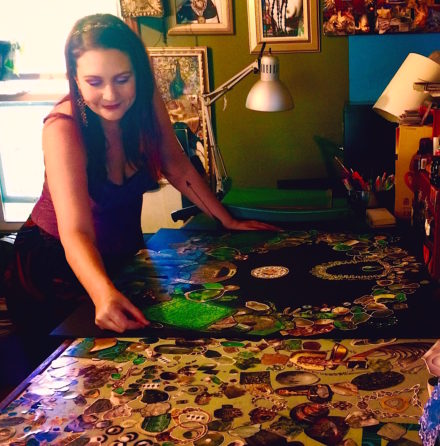
How have you evolved as an artist?
I studied drawing and painting in art school, and did that for about nine years, but the medium of collage came to me after an accident in which I broke my right wrist (my dominant hand). Because of the position of the cast, I could no longer hold a stylus, but I was able to use scissors and a glue stick. I experimented with several analog collage techniques and materials, and have since produced a huge body of work. I never returned to drawing and painting again.
This leap led me to new discoveries, and I experiment with fresh subject matter to keep myself interested. Commissions teach me a lot, as the parameters are set externally, usually by band members who are asking me to create a visual representation of their music. In adapting to their constraints, I am forced to work with a palate that I might have otherwise avoided.
How have you evolved as an entrepreneur?
I incorporate creative marketing ideas that require me to get out of my comfort zone. Rather than sticking to what I know and understand, I have tried to reach a wider audience and sought representation by more prestigious galleries. I’ve also gotten to know many sophisticated patrons who are doing amazing things in the art world. I pay attention and am trying to learn more about the business side of things—by knowing my numbers, testing my choices and decisions, and tracking the results.
I learn from my mistakes and pay attention to trends, keeping my finger on the pulse of the industry and the environments that surround it. Of course, there are limits to what one person can do—I am not privy to every aspect of the massive art world—but I try to absorb as much as I can.
What role do artists play in our society? What role SHOULD they play?
Artists can inform, relate, uplift, attack, or provoke. We take risks, adapt, and develop new ways of approaching our subject matter. Ours is an understanding of creative expression and invention, and an interest in communicating endless iterations of ideas, feelings, and experiences. The role that each artist plays is largely informed by her personality, chosen subject matter, and the culture of which she is a part.
Visual art has a different vocabulary than, say, music; feeling is communicated in another kind of language. In its interpretation of the world, art speaks, touching and challenging our consciousness in unexpected ways.
Anything else you would like us to know?
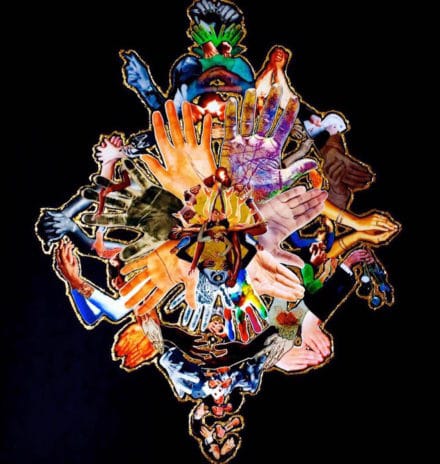
In addition to being a visual artist, I am also a massage therapist. I believe this direct work on the bodies of other humans has made me even more empathetic, strengthening my intuition and ability to nurture. The love of anatomy that I found in my figure-drawing classes was transformed into direct interaction with human bodies, which also requires the use of my hands.
I have been a massage therapist for more than seven years, and a few years ago I started my own healing-arts business, Vagabond Bodywork. Currently, I manage six other massage therapists and an acupuncturist. We provide professional massage and acupuncture services to musicians and their crews at festivals, concerts, and events. These are folks who are frequently on the road, sleeping in buses, vans, or a different hotel bed every night. The combination of late nights, poor diet, and (for some) substance use takes its toll on their bodies. Often, they are uninsured, or traveling so much that they rarely see a doctor. My team and I try to offset that as much we can. We provide preventive health care, as well as pain management for the repetitive stress injuries that are common among musicians.
For more information on Jodi Bee, see her official CHF bio.
[Photo of Jodi (top) by John Lucas]




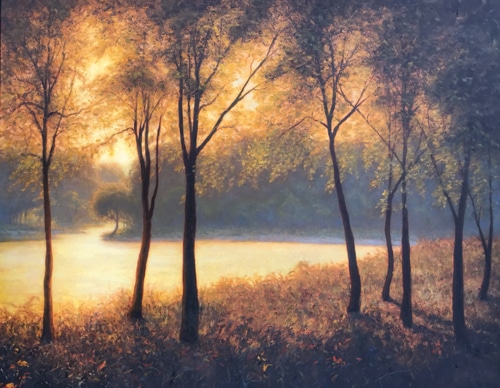
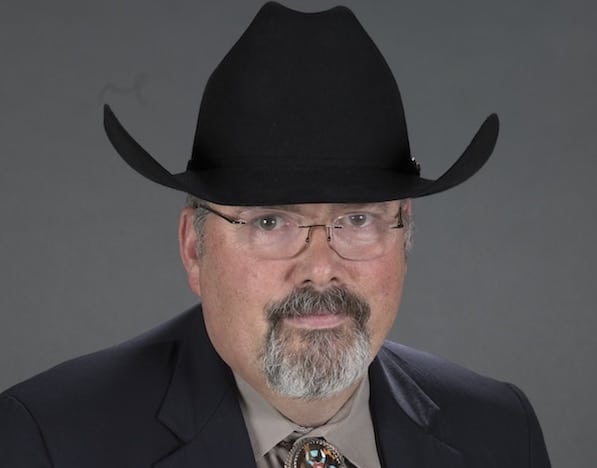
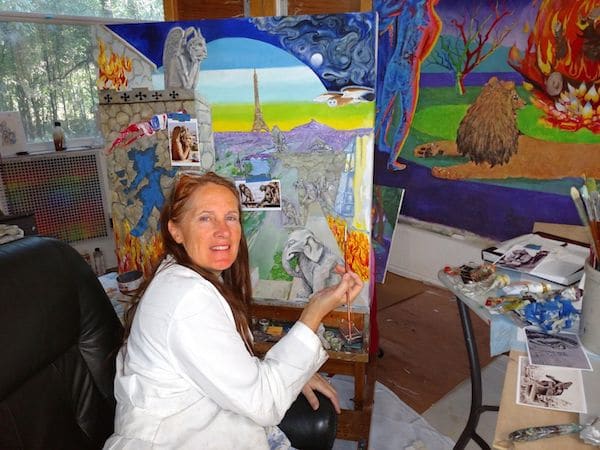
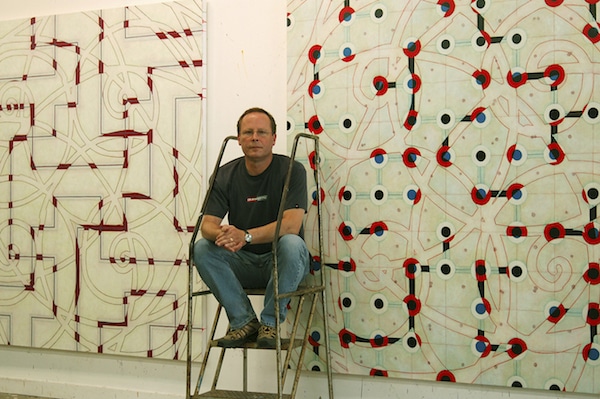

Jodi- Your hard work and dedication to art and life is awe-inspiring.
With love, Amy